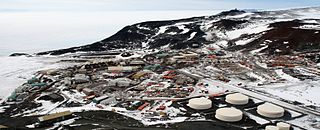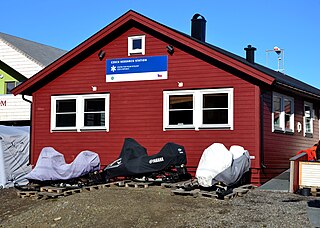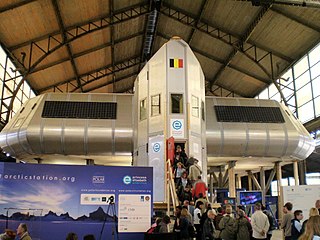
Casey Station, commonly called Casey, is one of three permanent stations and research outposts in Antarctica managed by the Australian Antarctic Division (AAD). Casey lies on the northern side of the Bailey Peninsula overlooking Vincennes Bay on the Budd Coast of Wilkes Land in the Australian Antarctic Territory, a territory claimed by Australia. Casey is 3,880 kilometres (2,410 mi) due south of Perth, Western Australia.

McMurdo Station is an American Antarctic research station on the southern tip of Ross Island, which is in the New Zealand–claimed Ross Dependency on the shore of McMurdo Sound in Antarctica. It is operated by the United States through the United States Antarctic Program (USAP), a branch of the National Science Foundation. The station is the largest community in Antarctica, capable of supporting up to 1,500 residents, and serves as one of three year-round United States Antarctic science facilities. All personnel and cargo going to or coming from Amundsen–Scott South Pole Station first pass through McMurdo. McMurdo Station continues to operate as the hub for American activities on the Antarctic continent. By road, McMurdo is 3 kilometres (1.9 mi) from New Zealand's smaller Scott Base.

The Amundsen–Scott South Pole Station is a United States scientific research station at the South Pole of the Earth. It is the southernmost point under the jurisdiction of the United States. The station is located on the high plateau of Antarctica at 9,301 feet (2,835 m) above sea level. It is administered by the Office of Polar Programs of the National Science Foundation, specifically the United States Antarctic Program (USAP). It is named in honor of Norwegian Roald Amundsen and Briton Robert F. Scott, who led separate teams that raced to become the first to the pole in the early 1900s.

Halley Research Station is a research facility in Antarctica on the Brunt Ice Shelf operated by the British Antarctic Survey (BAS). The base was established in 1956 to study the Earth's atmosphere. Measurements from Halley led to the discovery of the ozone hole in 1985. The current base is the sixth in a line of structures and includes design elements intended to overcome the challenge of building on a floating ice shelf without being buried and crushed by snow. As of 2020, the base has been left unstaffed through winter since 2017, due to concerns over the propagation of an ice crack and how this might cut off the evacuation route in an emergency.
Broadly speaking, modularity is the degree to which a system's components may be separated and recombined, often with the benefit of flexibility and variety in use. The concept of modularity is used primarily to reduce complexity by breaking a system into varying degrees of interdependence and independence across and "hide the complexity of each part behind an abstraction and interface". However, the concept of modularity can be extended to multiple disciplines, each with their own nuances. Despite these nuances, consistent themes concerning modular systems can be identified.

A modular building is a prefabricated building that consists of repeated sections called modules. Modularity involves constructing sections away from the building site, then delivering them to the intended site. Installation of the prefabricated sections is completed on site. Prefabricated sections are sometimes placed using a crane. The modules can be placed side-by-side, end-to-end, or stacked, allowing for a variety of configurations and styles. After placement, the modules are joined together using inter-module connections, also known as inter-connections. The inter-connections tie the individual modules together to form the overall building structure.

Research stations are facilities where scientific investigation, collection, analysis and experimentation occurs. A research station is a facility that is built for the purpose of conducting scientific research. There are also many types of research stations including: biological field stations, space stations etc. Research station sites might include remote areas of the world, oceans, as well as outer space, such as the International Space Station. Biological research stations developed during a time of European colonization and imperialism where naturalists were employed to conduct observations on fauna and flora. Today, the discipline is represented by a number of organizations which span across multiple continents. Some examples include: the Organization of Biological Field Stations and the Organization for Tropical Studies.

Formwork is molds into which concrete or similar materials are either precast or cast-in-place. In the context of concrete construction, the falsework supports the shuttering molds. In specialty applications formwork may be permanently incorporated into the final structure, adding insulation or helping reinforce the finished structure.

Modular design, or modularity in design, is a design principle that subdivides a system into smaller parts called modules, which can be independently created, modified, replaced, or exchanged with other modules or between different systems.

Shipping container architecture is a form of architecture that uses steel intermodal containers as the main structural element. It is also referred to as cargotecture or arkitainer, portmanteau words formed from "cargo" and "architecture". This form of architecture is often associated with the tiny-house movement as well as the sustainable living movement.

San Martín Base is a permanent, all year-round Argentine Antarctic base and scientific research station named after General José de San Martín, the Libertador of Argentina, Chile and Perú. It is located on Barry Island, Marguerite Bay, Antarctic Peninsula.

The Icebird is a cargo vessel which delivers supplies to the Australian Antarctic Division (AAD) bases, principally Macquarie Island, Mawson, Casey and Davis Stations. The Icebird's maiden voyage to Antarctica began when she departed from Cape Town, South Africa in November 1984. In 1996, the vessel was renamed Polar Bird.

Troll is a Norwegian research station located at Jutulsessen, 235 kilometres (146 mi) from the coast in the eastern part of Princess Martha Coast in Queen Maud Land, Antarctica. It is Norway's only all-year research station in Antarctica, and is supplemented by the summer-only station Tor. Troll is operated by the Norwegian Polar Institute and also features facilities for the Norwegian Meteorological Institute and the Norwegian Institute for Air Research.

The Comandante Ferraz Antarctic Station is a permanent Antarctic research station named after the Brazilian Navy Commander Luís Antônio de Carvalho Ferraz (1940–1982), who visited Antarctica many times with the British exploration team and managed to convince his government to create a self-guided Brazilian Antarctic Program.

Princess Elisabeth Antarctica, located on Utsteinen Nunatak in Queen Maud Land, is a Belgian scientific polar research station, which went into service on 15 February 2009.

Plateau Station is an inactive American research and South Pole—Queen Maud Land Traverse support base on the central Antarctic Plateau. Construction on the site started on December 13, 1965, and the first traverse team arrived in early 1966. The base was in continuous use until January 29, 1969, when it was closed but mothballed for future use, and was the most remote and coldest of any United States stations on the continent. It was also the site for the world's coldest measured average temperature for a month at that time, recorded in July 1968, at −99.8 °F (−73.2 °C).

Modular construction is a construction technique which involves the prefabrication of 2D panels or 3D volumetric structures in off-site factories and transportation to construction sites for assembly. This process has the potential to be superior to traditional building in terms of both time and costs, with claimed time savings of between 20 and 50 percent faster than traditional building techniques.

StanFlex is a modular mission payload system used by the Royal Danish Navy. Originally conceived during the 1980s as a way of replacing several classes of minor war vessel with a single class of multi-role ships, the StanFlex system consists of weapons and equipment mounted in standardised containers, which can be loaded into slots on the ships. These containers can be swapped out in a short period of time, allowing the ship to switch between roles when needed. The success of the modular payload system led the Royal Danish Navy to design all new warships with StanFlex slots, and to install slots on older vessels during major refits. By 2012, nine ship classes capable of carrying StanFlex payloads were in service.
The Wasa Research Station is a Swedish research facility in Antarctica, established in 1988/1989. It is situated next to the Finnish Aboa Research Station on the Basen nunatak in the Kraul Mountains in Queen Maud Land. The two stations cooperate, and are jointly referred to as the Nordenskiöld Base Camp.
J.G. Mendel Czech Antarctic Station is a Czech research station in Antarctica on the coast of James Ross Island. It was founded by a Czech polar explorer Pavel Prošek. The official opening ceremony took place in February 2007 and made the Czech Republic the 26th country to have its own scientific base on the continent. The station is the property of Masaryk University in Brno and was named after the father of modern genetics, the meteorologist Gregor Johann Mendel. Thanks to the research carried out at the station, the Czech Republic is one of the countries who have a voting right in the Antarctic Treaty System.
















